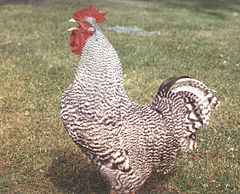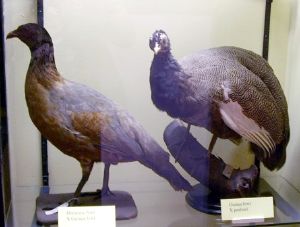Difference between revisions of "Fowl" - New World Encyclopedia
Rick Swarts (talk | contribs) (added article from Wikipedia and credit/category tags) |
Rick Swarts (talk | contribs) |
||
| Line 48: | Line 48: | ||
==References== | ==References== | ||
| + | |||
| + | Mindell, David P. and Joseph W. Brown. 2007. Galloanserae. Version 07 March 2007 (temporary). http://tolweb.org/Galloanserae/15840/2007.03.07 in The Tree of Life Web Project, http://tolweb.org/ | ||
| + | |||
| + | |||
| + | |||
*{{aut|Benson, D.}} (1999): ''Presbyornis isoni'' and other late Paleocene birds from North Dakota. ''Smithsonian Contributions to Paleobiology'' '''89''': 253-266. | *{{aut|Benson, D.}} (1999): ''Presbyornis isoni'' and other late Paleocene birds from North Dakota. ''Smithsonian Contributions to Paleobiology'' '''89''': 253-266. | ||
*{{aut|Chubb, A.}} (2004): New nuclear evidence for the oldest divergence among neognath birds: the phylogenetic utility of ZENK(i). ''Molecular Phylogenetics and Evolution'' '''30''': 140-151 | *{{aut|Chubb, A.}} (2004): New nuclear evidence for the oldest divergence among neognath birds: the phylogenetic utility of ZENK(i). ''Molecular Phylogenetics and Evolution'' '''30''': 140-151 | ||
Revision as of 21:48, 11 November 2008
- For other uses, see Fowl (disambiguation).
| Galloanserans
| ||||||||||||
|---|---|---|---|---|---|---|---|---|---|---|---|---|
 Chickens are a well-known member of this ancient clade
| ||||||||||||
| Scientific classification | ||||||||||||
| ||||||||||||
|
Anseriformes | ||||||||||||
|
Galloanseri |
Most or all birds collectively referred to as fowl belong to one of two orders, namely the gamefowl or landfowl (Galliformes) and the waterfowl (Anseriformes). Interestingly, studies of anatomical and molecular similarities suggest these two groups were close evolutionary relatives; together, they form the fowl clade which is scientifically known as Galloanserae (initially termed Galloanseri)[1]. This clade is also supported by morphological and DNA sequence data[2] as well as retrotransposon presence/absence data[3].
Terminology
As opposed to "fowl", "poultry" is a term for any kind of domesticated bird or bird captive-raised for meat or eggs; ostriches for example are sometimes kept as poultry, but are neither gamefowl nor waterfowl. In colloquial speech, the term "fowl" is however often used near-synonymously with "poultry" or even "bird", and many languages do not distinguish between "poultry" and "fowl". Nonetheless, the fact that Galliformes and Anseriformes most likely form a monophyletic group makes a distinction between "fowl" and "poultry" warranted.
Many birds that are eaten by humans are fowl, including poultry such as chickens or turkeys, game birds such as pheasants or partridges, other wildfowl like guineafowl or peafowl, and waterfowl such as ducks or geese.
Characteristics
While they are extremely diverse ecologically and consequently, in an adaptation to their different lifestyles, also morphologically and ethologically, there are still some features which unite water- and landfowl. Many of these, however, are plesiomorphic for Neornithes as a whole, and are also shared with paleognaths.
- Galloanserae are very prolific; they regularly produce clutches of more than 5 or even more than 10 eggs, which is a lot for such sizeable birds. For example birds of prey and pigeons rarely lay more than two eggs.
- While most living birds are monogamous, at least for a breeding season, many Galloanserae are notoriously polygynous or polygamous. To ornithologists, this is particularly well-known in dabbling ducks, where the males literally band together occasionally to "gang rape" unwilling females. The general public is probably most familiar with the polygynous habits of domestic chicken, where usually one or two roosters are kept with a whole flock of females.
- Hybridization is extremely frequent in Galloanserae, and genera, not usually known to produce viable hybrids in birds, can be brought to interbreed with comparative ease. Guineafowl have successfully produced hybrids with domestic fowl and Blue Peafowl, to which are not particularly closely related as Galliformes go. This is an important factor complicating mtDNA sequence-based research on their relationships. The Mallards of North America, for example, are apparently mostly derived from some males which arrived from Siberia, settled down, and mated with American Black Duck ancestors[4]. See also Gamebird hybrids.
- Galloanserae young are remarkably precocious. Anseriform young are able to swim and dive a few hours after hatching, and the hatchlings of mound-builders are fully feathered and even able to fly for prolonged distances as soon as they emerge from the nest mound.
Systematics and evolution
Fowl were the first neognath lineages to evolve. From the limited fossils that have to date been recovered, the conclusion that they were already widespread - indeed the predominant group of modern birds - by end of the Cretaceous is generally accepted nowadays. Fossils such as Vegavis indicate that essentially modern waterfowl - albeit belonging to a nowadays extinct lineage - were contemporaries of the (non-avian) dinosaurs. As opposed to the morphologically fairly conservative Galliformes, the Anseriformes have adapted to filter-feeding and are characterized by a large number of autapomorphies related to this lifestyle. The extremely advanced feeding systems of the Anseriformes, together with similarities of the early anseriform Presbyornis to shorebirds, had formerly prompted some scientists to ally Anseriformes with Charadriiformes instead[5] (see also "Graculavidae")[6]. However, as strong support for the Galloanserae has emerged in subsequent studies, the fowl clade continues to be accepted as a genuine evolutionary lineage by the vast majority of scientists.
Apart from the living members, the Gastornithiformes are probably a prehistoric member of the Galloanserae.
Footnotes
ReferencesISBN links support NWE through referral fees
Mindell, David P. and Joseph W. Brown. 2007. Galloanserae. Version 07 March 2007 (temporary). http://tolweb.org/Galloanserae/15840/2007.03.07 in The Tree of Life Web Project, http://tolweb.org/
- Benson, D. (1999): Presbyornis isoni and other late Paleocene birds from North Dakota. Smithsonian Contributions to Paleobiology 89: 253-266.
- Chubb, A. (2004): New nuclear evidence for the oldest divergence among neognath birds: the phylogenetic utility of ZENK(i). Molecular Phylogenetics and Evolution 30: 140-151
- EvoWiki (2008): Galloanserae: A Critical Examination. Version of 2008-05-21. Retrieved 2008-06-15.
- Feduccia, A. (1999): The Origin and Evolution of Birds, Second Edition. Yale University Press, New Haven.
- Kriegs, Jan Ole; Matzke, Andreas; Churakov, Gennady; Kuritzin, Andrej; Mayr, Gerald; Brosius, Jürgen & Schmitz, Jürgen (2007): Waves of genomic hitchhikers shed light on the evolution of gamebirds (Aves: Galliformes). BMC Evolutionary Biology 7: 190 (Fulltext).
- Kulikova, Irina V.; Drovetski, S.V.; Gibson, D.D.; Harrigan, R.J.; Rohwer, S.; Sorenson, Michael D.; Winker, K.; Zhuravlev, Yury N. & McCracken, Kevin G. (2005): Phylogeography of the Mallard (Anas platyrhynchos): Hybridization, dispersal, and lineage sorting contribute to complex geographic structure. Auk 122 (3): 949-965. [English with Russian abstract] DOI: 10.1642/0004-8038(2005)122[0949:POTMAP]2.0.CO;2 PDF fulltext. Erratum: Auk 122 (4): 1309. DOI: 10.1642/0004-8038(2005)122[0949:POTMAP]2.0.CO;2
- Sibley, C.G.; Ahlquist, J.E. & Monroe, B.L. (1988): A classification of the living birds of the world based on DNA-DNA hybridization studies. Auk 105: 409-423.
Credits
New World Encyclopedia writers and editors rewrote and completed the Wikipedia article in accordance with New World Encyclopedia standards. This article abides by terms of the Creative Commons CC-by-sa 3.0 License (CC-by-sa), which may be used and disseminated with proper attribution. Credit is due under the terms of this license that can reference both the New World Encyclopedia contributors and the selfless volunteer contributors of the Wikimedia Foundation. To cite this article click here for a list of acceptable citing formats.The history of earlier contributions by wikipedians is accessible to researchers here:
The history of this article since it was imported to New World Encyclopedia:
Note: Some restrictions may apply to use of individual images which are separately licensed.
